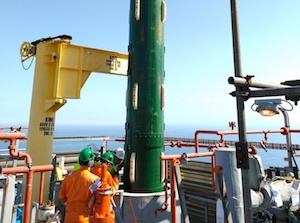“This equipment is designed to stop the transportation of hydrocarbons to the onshore processing facility (OPF) in case of emergency,” says Sergey Stepovikov, LUN-A OIM.
To open the valve and replace its parts, we had to isolate it from the pipeline under pressure. There are several technologies in the world that make it possible to perform such an operation. The company chose the most reliable method: the installation of a remotely controlled isolation device, which saves the trouble of completely bleeding the pressure in the pipeline. The use of the device reduces gas losses to a minimum.
“At the command of the operator, the isolation device closes the necessary section of the pipe and ensures its complete tightness. After the repair is finished, the device receives a signal, returns to its original position, and is then pulled out,” explains Alexey Gulyaev, Sakhalin Energy Pipelines Operations Manager.
The installation of the isolation device was preceded by a considerable amount of preparatory work. This included the manufacture of a special stand for testing the cap in simulated conditions. The testing allowed the team to analyse more than 100 development scenarios.
According to Maxim Ognev, Head of the Offshore Assets Shutdown Planning Subdivision, a number of other complex activities, in particular, the replacement of two large-sized valves, the inspection and cleaning of a three-phase separator, were successfully completed on the platform as part of the shutdown.
Maxim Ognev added: “All equipment was first tested for operability and safety. It was put into operation only after we had received the necessary confirmation. In fact, it was the most large-scale shutdown that the LUN-A platform had ever seen. It had taken us two years to prepare for the turnaround. Thanks to the thorough preparation, we were able to complete the work on time and in compliance with all safety requirements.”


